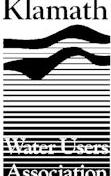
Klamath Water Users Association
April 17, 2003
Study Shows That Klamath River Temperatures – Not Klamath Project Operations – Are Likely Reason for 2002 Fish Die-Off
|
|
Klamath Water Users Association
April 17, 2003 Study Shows That Klamath River Temperatures – Not Klamath Project Operations – Are Likely Reason for 2002 Fish Die-Off
|
Traditional advocates of high mainstem Klamath River flows quickly concluded last fall that the fish die-off was due in large part to Klamath Project operations, despite the fact that the fish died below the confluence of the Klamath and Trinity rivers, 200 miles downstream of the Klamath Project. Dave Vogel, a fisheries biologist with 28 years of experience (see attached biography), believes that Klamath River water temperatures are extremely important in this issue because of the adverse impact high water temperatures can have on salmon (such as causing disease outbreaks). The topic is also important because of how water project operations can, or cannot, affect water temperatures in riverine areas important to salmon. 2002 Findings During late summer and early fall of 2002, Dave Vogel conducted a field investigation to assess water temperatures in the main stem Klamath River: Main stem water temperatures were measured hourly just prior to and during the fall-run Chinook salmon migration season. Vogel found that water temperatures in the upper Klamath River downstream of Iron Gate Dam during September 2002 were unsuitable for adult salmon. This finding was similar to that of previous studies. As expected, a normal seasonal cooling trend at the end of September and early October provided the moderating influence lowering Klamath River temperatures to tolerable levels for salmon. Vogel also found that large numbers of salmon entered the lower Klamath River earlier than usual and were exposed to two dramatic and uncharacteristic cooling and warming conditions causing disease outbreak from warm water and crowded conditions. The combination of these factors was chronically and cumulatively stressful to fish and is probably the most plausible reason for the fish die-off. Past Studies Support the 2002 Investigation Results: Iron Gate Dam Releases Are Too Warm for Salmon in Late August and Early September Preliminary Assessment of Increased Klamath River Flows for Salmon During the Late Summer and Fall of 1994. D.A. Vogel and K.R. Marine, Red Bluff, California (November 1994) In 1994, fisheries biologist David Vogel co-authored a technical report which concluded that: Any increased flows from Iron Gate Dam, pulsed or otherwise, to benefit adult salmon should only occur during late September or early October to coincide with normal seasonal declines in air temperatures and concomitant cooler river flows. Earlier seasonal increased releases from Iron Gate Dam are unlikely to provide biological benefits because the water is naturally too warm. Based on his research in 2002, Vogel’s conclusions remain the same. Assessment of Alternatives for Flow and Water Quality Control in the Klamath River Below Iron Gate Dam. M.L. Deas and G.T. Orlob, Center for Environmental and Water Resources Engineering, University of California, Davis. December 1999. Vogel’s conclusions concerning the effect of Iron Gate Dam releases and upper main stem Klamath River water temperatures in the fall are similar to the findings of other researchers. For example, Deas and Orlob (1999) found the following: “During early fall, mean daily measured water temperatures are fairly uniform throughout the river system. However, by late fall it is apparent that temperatures are decreasing in the downstream direction by late fall, i.e., after October 1. During this period, releases from Iron Gate Dam are generally at temperatures above equilibrium and the reservoir is acting as a heat source to the river.” Study Shows That Klamath River Temperatures – Not Klamath Project Operations – Are Likely Reason for 2002 Fish Die-Off Conclusion It appears that large numbers of salmon entered the lower Klamath River earlier than usual, were exposed to two dramatic and uncharacteristic cooling and warming conditions that were chronically and cumulatively stressful to fish. At the same time, riverine conditions in the upper Klamath River were unsuitably warm for salmon because the normal seasonal cooling trend had not yet occurred. These data indicate that September 2002 was unique, but not for the reasons portrayed by the California Department of Fish and Game. Until additional data is acquired on the topic, Vogel’s opinion is that the combination of those factors is probably the most plausible reason for the fish die-off. “In my opinion, the best available scientific data and information indicate that the continued operation and maintenance of historical flows at Iron Gate Dam will not jeopardize coho salmon. Furthermore, in my opinion the operations of Iron Gate Dam during the summer and fall of 2002 did not cause and could not have prevented the fish die-off in the lower Klamath River.” Dave Vogel, March 2003 |
|
Klamath Water Users
Association |
Content and Logo: Copyright © Klamath
Water Users Association, 2002 All Rights
Reserved
Page design: Copyright ©
klamathbasincrisis.org, 2002, All Rights
Reserved